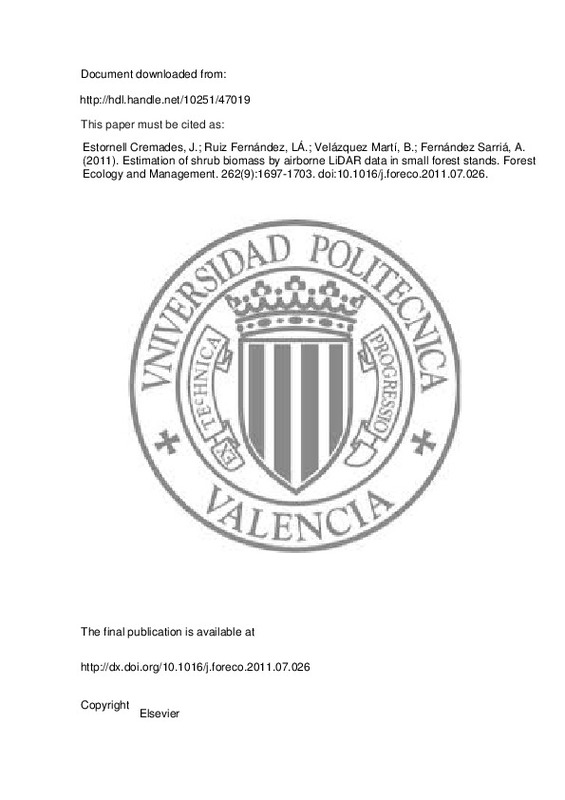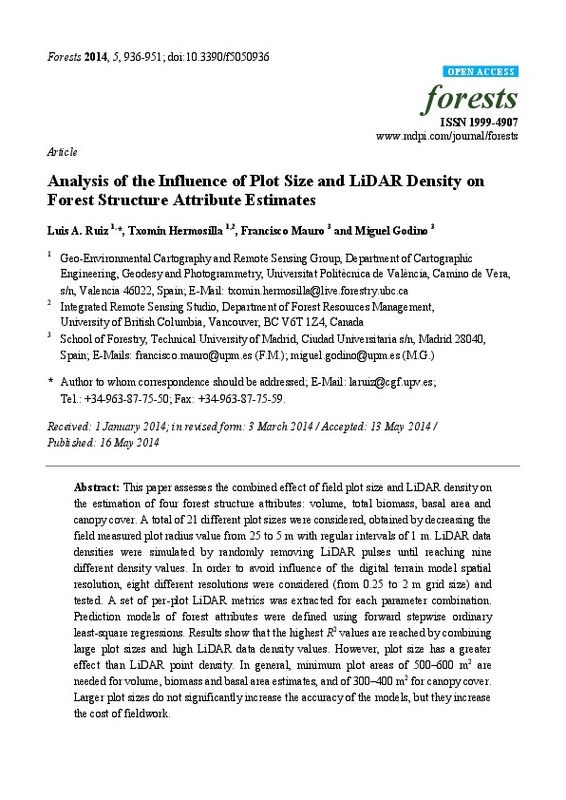Estornell Cremades, J.; Ruiz Fernández, LÁ.; Velázquez Martí, B.; Fernández Sarriá, A. (2011). Estimation of shrub biomass by airborne LiDAR data in small forest stands. Forest Ecology and Management. 262(9):1697-1703. doi:10.1016/j.foreco.2011.07.026
Por favor, use este identificador para citar o enlazar este ítem: http://hdl.handle.net/10251/47019
|
Título:
|
Estimation of shrub biomass by airborne LiDAR data in small forest stands
|
|
Autor:
|

 Estornell Cremades, Javier
Estornell Cremades, Javier

 Ruiz Fernández, Luis Ángel
Ruiz Fernández, Luis Ángel

 Velázquez Martí, Borja
Velázquez Martí, Borja

 Fernández Sarriá, Alfonso
Fernández Sarriá, Alfonso
|
|
Entidad UPV:
|
Universitat Politècnica de València. Departamento de Ingeniería Cartográfica Geodesia y Fotogrametría - Departament d'Enginyeria Cartogràfica, Geodèsia i Fotogrametria
Universitat Politècnica de València. Departamento de Ingeniería Rural y Agroalimentaria - Departament d'Enginyeria Rural i Agroalimentària
Universitat Politècnica de València. Grupo de Cartografía Geoambiental y Teledetección
Universitat Politècnica de València. Grupo de Mecanización y Tecnología Agraria
|
|
Fecha difusión:
|
|
|
Resumen:
|
The presence of shrub vegetation is very significant in Mediterranean ecosystems. However, the difficulty involved in shrub management and the lack of information about behavior of this vegetation means that these areas ...[+]
The presence of shrub vegetation is very significant in Mediterranean ecosystems. However, the difficulty involved in shrub management and the lack of information about behavior of this vegetation means that these areas are often left out of spatial planning projects. Airborne LiDAR (Light Detection And Ranging) has been used successfully in forestry to estimate dendrometric and dasometric variables that allow to characterize forest structure. In contrast, little research has focused on shrub vegetation. The objective of this study was to estimate dry biomass of shrub vegetation in 83 stands of radius 0.5 m using variables derived from LiDAR data. Dominant species was Quercus coccifera, one of the most characteristic species of the Mediterranean forests. Density of LiDAR data in the analyzed stands varied from 2 points/m(2) to 16 points/m(2), being the average 8 points/m(2) and the standard deviation 4.5 points/m(2). Under these conditions, predictions of biomass were performed calculating the mean height, the maximum height and the percentile values 80th, 90th, and 95th derived from LiDAR in concentric areas whose radius varied from 0.50 m to 3.5 m from the center of the stand. The maximum R(2) and the minimum RMSE for dry biomass estimations were obtained when the percentile 95th of LiDAR data was calculated in an area of radius 1.5 m, being 0.48 and 1.45 kg, respectively. For this radius, it was found that for the stands (n = 39) where the DTM is calculated with high accuracy (RMSE lower than 0.20 m) and with a high density of LiDAR data (more than 8 points/m(2)) the R(2) value was 0.73. These results show the possibility of estimating shrub biomass in small areas when the density of LiDAR data is high and errors associated to the DTM are low. These results would allow us to improve the knowledge about shrub behavior avoiding the cost of field measurements and clear cutting actions. (C) 2011 Elsevier B.V. All rights reserved.
[-]
|
|
Palabras clave:
|
Biomass
,
DTM
,
Forest management
,
LiDAR
,
Shrub
,
Airborne LiDAR
,
Airborne lidar data
,
Dominant species
,
Dry biomass
,
Field measurement
,
Forest stand
,
Forest structure
,
High density
,
LIDAR data
,
Little research
,
Mediterranean ecosystem
,
Mediterranean forest
,
Quercus
,
Small area
,
Spatial planning
,
Standard deviation
,
Estimation
,
Forestry
,
Planning
,
Temperature control
,
Vegetation
,
Optical radar
,
Accuracy assessment
,
Clearcutting
,
Cost-benefit analysis
,
Data set
,
Deciduous forest
,
Dominance
,
Error analysis
,
Estimation method
,
Forest ecosystem
,
Height determination
,
Mediterranean environment
,
Phytomass
,
Prediction
,
Stand structure
,
Quercus coccifera
|
|
Derechos de uso:
|
Reserva de todos los derechos
|
|
Fuente:
|
Forest Ecology and Management. (issn:
0378-1127
)
|
|
DOI:
|
10.1016/j.foreco.2011.07.026
|
|
Editorial:
|
Elsevier
|
|
Versión del editor:
|
http://dx.doi.org/10.1016/j.foreco.2011.07.026
|
|
Tipo:
|
Artículo
|







![[Cerrado]](/themes/UPV/images/candado.png)




